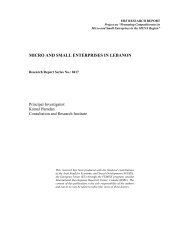View - ResearchGate
View - ResearchGate
View - ResearchGate
You also want an ePaper? Increase the reach of your titles
YUMPU automatically turns print PDFs into web optimized ePapers that Google loves.
autoregressive models). These problems are especially important to address if one likes to use<br />
non-linear models such as those in the ARCH class. Using Autoregressive (AR) models we<br />
can capture the dynamics of the growth variable with lagged dependent variables. It is<br />
plausible that growth rate is also affected by growth variability. Therefore, we include the<br />
conditional variance of the residual (ε t ) as h t in the growth equation:<br />
n<br />
Growth t = β 0 + ∑ i =<br />
β<br />
1 i Growth t-1 + β h h t + ε t (1)<br />
where Growth t is the growth rate at time t, ε t has a zero mean and a time varying conditional<br />
variance of h t at the given information set at time t-1,Ω t-1 .<br />
ε t / Ω t-1 ~ ( 0,h t ). (2)<br />
Here h t captures the variability of growth. Nelson (1991) proposed the following model for<br />
the logarithm of the conditional variance.<br />
P<br />
Log h t = ς + ∑<br />
j=<br />
1<br />
Pj<br />
q ⎪⎧<br />
Log h t-j + ∑θ<br />
j<br />
⎨<br />
j=<br />
1 ⎪⎩<br />
ε<br />
h<br />
t−<br />
j<br />
t−<br />
j<br />
− E<br />
This model is referred to as the Exponential-Generalized Autoregressive Conditional<br />
Heteroskedastic (EGARCH) model. If one interprets P j as the coefficients of the lag values of<br />
the logarithm of the conditional variance, then the characteristic roots of the process should<br />
be outside the unit circle for the non-explosiveness of the conditional variance.<br />
Nelson’s (1991) specification models the logarithm of the conditional variance rather than the<br />
conditional variance, which provides some advantages. One advantage of the EGARCH<br />
model is that the variance (h t ) itself will be positive, regardless of whether the P j and θ j<br />
coefficients are positive or negative. This makes numerical optimization simpler and allows a<br />
more flexible class of possible dynamic models of the variance (Hamilton, 1994). Moreover,<br />
this specification allows asymmetry to be measured through the leverage effect (positive and<br />
negative innovations to growth specification affect volatility differently).<br />
In order to permit interaction between growth and the transmission variables, multi-AR<br />
models are used instead of Vector-AR specifications. The conventional Vector-AR model<br />
uses the lag values of all elements in an X vector to explain the behavior of each variable in<br />
the X vector. Specifically, if X includes growth, TFP, employment, exchange rate, and<br />
investment, then in the first equation, the right hand side will include their lag values, that is,<br />
putting too many variables to the right-hand side to explain growth and each of these<br />
variables and ending up with a low degree of freedom. Moreover, note that TFP, investment<br />
(as a ratio to GDP), and growth all use GDP in their calculations. A non-linear relationship<br />
exists among these variables. Due to the high collinearity among these variables<br />
(multicollinearity), estimates will also be less efficient if we use a Vector-AR specification.<br />
In order to account for this, we suggest the following:<br />
i. Instead of modeling all these variables simultaneously, two variables are modeled at a<br />
time. The first variable is growth, to extract the growth volatility, and the second variable is<br />
TFP, investment, exchange rate, or employment. If we had only one variable set (Xt includes<br />
only one variable), this model would be similar to Speight’s (1999) work and the references<br />
cited therein.<br />
ii. Each variable is modeled with its own lags rather than the lags of other variables, to stop<br />
the high collinearity among each set of variables from affecting the results.<br />
Next, the effects of the conditional variance of growth on a set of variables, including TFP,<br />
investment, exchange rate, and employment are examined using the following specification,<br />
ε<br />
h<br />
t−<br />
j<br />
t−<br />
j<br />
+ δ<br />
ε<br />
h<br />
t−<br />
j<br />
t−<br />
j<br />
⎪⎫<br />
⎬<br />
⎪⎭<br />
(3)<br />
4

















